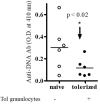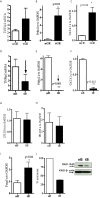Effects of Peptide-Induced Immune Tolerance on Murine Lupus
- PMID: 34093553
- PMCID: PMC8171184
- DOI: 10.3389/fimmu.2021.662901
Effects of Peptide-Induced Immune Tolerance on Murine Lupus
Abstract
The regulation of autoimmunity and the molecular mechanisms by which different immune cells, including T cells, polymorphonuclear leukocytes (PMN-granulocytes), and B cells suppress autoimmune diseases is complex. We have shown previously that BWF1 lupus mice are protected from autoimmunity after i.v. injection or oral administration of tolerogenic doses of pCons, an artificial synthetic peptide based on sequences containing MHC class I and MHC class II determinants in the VH region of a J558-encoded BWF1 anti-DNA Ab. Several T cell subsets can transfer this tolerance. In this study, we determined the potential roles of granulocytes, B cells and regulatory T cells altered by pCons treatment in the BWF1 (NZB/NZW) mouse model of lupus. Immunophenotyping studies indicated that pCons treatment of BWF1 mice significantly increased CD4+FoxP3+ T cells, reduced the percent of B cells expressing CD19+CD5+ but increased the percent of CD19+CD1d+ regulatory B cells and increased the ability of the whole B cell population to suppress IgG anti-DNA production in vitro. pCons treatment significantly decreased the expression of CTLA-4 (cytotoxic T-lymphocyte-associated protein-4) in CD8+ T cells. In addition, peptide administration modified granulocytes so they became suppressive. We co-cultured sorted naïve B cells from mice making anti-DNA Ab (supported by addition of sorted naive CD4+ and CD8+ T cells from young auto-antibody-negative BWF1 mice) with sorted B cells or granulocytes from tolerized mice. Both tolerized granulocytes and tolerized B cells significantly suppressed the production of anti-DNA in vitro. In granulocytes from tolerized mice compared to saline-treated littermate controls, real-time PCR analysis indicated that expression of interferon-induced TNFAIP2 increased more than 2-fold while Ptdss2 and GATA1 mRNA were up-regulated more than 10-fold. In contrast, expression of these genes was significantly down-regulated in tolerized B cells. Further, another IFN-induced protein, Bcl2, was reduced in tolerized B cells as determined by Western blot analyses. In contrast, expression of FoxP3 was significantly increased in tolerized B cells. Together, these data suggest that B cells and granulocytes are altered toward suppressive functions by in vivo tolerization of BWF1 mice with pCons and it is possible these cell types participate in the clinical benefits seen in vivo.
Keywords: Anti-DNA Ab; granulocytes; immune tolerance and regulation; pConsensus peptide (pCons); polymorphonuclear cells (PMNs); regulatory B cells; systemic lupus erythematosus.
Copyright © 2021 Singh, Hahn and Bischoff.
Conflict of interest statement
BHH and RPS have a patent through the University of California, Los Angeles for the use of pCons as an immune modulator in systemic lupus erythematosus. The remaining author declares that the research was conducted in the absence of any commercial or financial relationships that could be construed as a potential conflict of interest.
Figures





Similar articles
-
pConsensus peptide induces tolerogenic CD8+ T cells in lupus-prone (NZB x NZW)F1 mice by differentially regulating Foxp3 and PD1 molecules.J Immunol. 2008 Feb 15;180(4):2069-80. doi: 10.4049/jimmunol.180.4.2069. J Immunol. 2008. PMID: 18250412
-
Cellular and Molecular Phenotypes of pConsensus Peptide (pCons) Induced CD8+ and CD4+ Regulatory T Cells in Lupus.Front Immunol. 2021 Nov 19;12:718359. doi: 10.3389/fimmu.2021.718359. eCollection 2021. Front Immunol. 2021. PMID: 34867947 Free PMC article.
-
Interferon-inducible gene 202b controls CD8(+) T cell-mediated suppression in anti-DNA Ig peptide-treated (NZB × NZW) F1 lupus mice.Genes Immun. 2011 Jul;12(5):360-9. doi: 10.1038/gene.2011.4. Epub 2011 Feb 17. Genes Immun. 2011. PMID: 21326316 Free PMC article.
-
Harnessing Tolerogenic Histone Peptide Epitopes From Nucleosomes for Selective Down-Regulation of Pathogenic Autoimmune Response in Lupus (Past, Present, and Future).Front Immunol. 2021 Apr 14;12:629807. doi: 10.3389/fimmu.2021.629807. eCollection 2021. Front Immunol. 2021. PMID: 33936042 Free PMC article. Review.
-
Cellular and molecular mechanisms of regulation of autoantibody production in lupus.Ann N Y Acad Sci. 2005 Jun;1051:433-41. doi: 10.1196/annals.1361.085. Ann N Y Acad Sci. 2005. PMID: 16126985 Free PMC article. Review.
Cited by
-
CD8+ T regulatory cells in lupus.Rheumatol Immunol Res. 2021 Dec 15;2(3):147-156. doi: 10.2478/rir-2021-0021. eCollection 2021 Sep 1. Rheumatol Immunol Res. 2021. PMID: 35880241 Free PMC article. Review.
-
Dietary Supplementation with Transgenic Camelina sativa Oil Containing 20:5n-3 and 22:6n-3 or Fish Oil Induces Differential Changes in the Transcriptome of CD3+ T Lymphocytes.Nutrients. 2021 Sep 5;13(9):3116. doi: 10.3390/nu13093116. Nutrients. 2021. PMID: 34578993 Free PMC article. Clinical Trial.
-
Peptide-based immunotherapy in lupus: Where are we now?Rheumatol Immunol Res. 2023 Sep 27;4(3):139-149. doi: 10.2478/rir-2023-0020. eCollection 2023 Sep. Rheumatol Immunol Res. 2023. PMID: 37781681 Free PMC article. Review.
-
The Use of Peptides in Veterinary Serodiagnosis of Infectious Diseases: A Review.Vet Sci. 2022 Oct 12;9(10):561. doi: 10.3390/vetsci9100561. Vet Sci. 2022. PMID: 36288174 Free PMC article. Review.
References
Publication types
MeSH terms
Substances
LinkOut - more resources
Full Text Sources
Medical
Molecular Biology Databases
Research Materials

